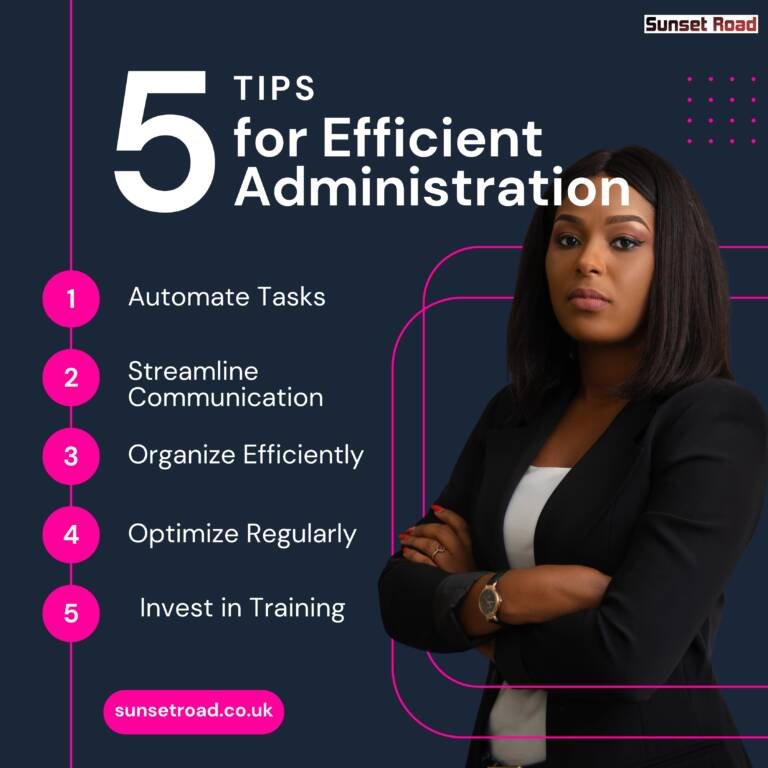Top 5 Strategies for Business Administration

Efficiency in business administration isn’t just about getting things done it’s about doing them smartly and effectively. By optimizing your workflow, you can maximize productivity, minimize wasted time, and foster a more streamlined operation. Here’s an in-depth look at the top five strategies to achieve efficient administration.
1. Automate Tasks
Automation is the cornerstone of modern efficiency. It involves using technology to handle repetitive tasks, freeing up valuable time for your team to focus on more strategic activities.
How to Implement:
-
- Workflow Analysis: Identify tasks that are repetitive and time-consuming, such as data entry, invoice processing, or email responses.
-
- Automation Tools: Utilize tools like Zippier, Integrate, or Microsoft Power Automate to create automated workflows between your business applications.
-
- Custom Solutions: Consider custom software solutions tailored to your specific business needs, which can automate complex processes like inventory management or customer support.
Benefits:
-
- Time Savings: Automating tasks reduces manual effort, allowing your team to allocate their time more efficiently.
-
- Accuracy: Automation minimizes human error, ensuring consistent results and reducing the need for corrections.
-
- Scalability: As your business grows, automated systems can easily scale to accommodate increased workload without proportional increases in labor.
2.Streamline Communication
Effective communication lies at the heart of operational efficiency. By centralizing and optimizing communication channels, you can enhance collaboration, clarity, and responsiveness within your team.
How to Implement:
-
- Unified Platforms: Adopt communication tools like Slack, Microsoft Teams, or Discord to consolidate conversations, file sharing, and project updates.
-
- Clear Protocols: Establish communication protocols, such as response times for emails or guidelines for using messaging apps, to ensure timely and effective communication.
-
- Regular Updates: Conduct regular team meetings or daily stand-ups to keep everyone informed about project statuses, goals, and challenges
Benefits:
-
- Improved Collaboration: Centralized communication fosters better teamwork, alignment on goals, and collective problem-solving.
-
- Reduced Delays: Faster decision-making and fewer misunderstandings lead to quicker project turnaround times and smoother operations.
-
- Enhanced Accountability: Clear communication protocols promote accountability, ensuring that tasks are completed on schedule and with the necessary quality.
3. Organize Efficiently
A well-organized workspace whether digital or physical is crucial for maintaining productivity and minimizing unnecessary disruptions.
How to Implement:
-
- Digital Organization: Utilize cloud storage solutions such as Google Drive or Dropbox to store and categorize documents logically. Implement version control and access permissions to manage document integrity and security.
-
- Physical Setup: Maintain a clutter-free physical workspace with well-labeled filing systems for easy document retrieval and storage.
-
- Document Management: Establish standardized naming conventions for files and folders to facilitate quick searches and reduce confusion.
Benefits:
-
- Time Efficiency: Organized systems reduce the time spent searching for information, enabling quicker decision-making and task completion.
-
- Risk Mitigation: Improved document management reduces the risk of misplaced or lost information, ensuring business continuity and compliance with regulatory requirements.
4. Optimize Regularly
Continuous improvement is essential for staying competitive and adapting to changing business environments. Regularly assessing and refining administrative processes ensures that they remain effective and aligned with your business goals.
How to Implement:
-
- Process Audits: Conduct periodic audits to identify bottlenecks, redundancies, or inefficiencies in your workflows.
-
- Feedback Loops: Encourage team members to provide feedback on existing processes and propose suggestions for improvement.
-
- Benchmarking: Compare your administrative practices against industry best practices and trends to identify opportunities for innovation and enhancement.
Benefits:
-
- Adaptability: Regular optimization ensures that your business remains agile and responsive to market changes and customer demands.
-
- Cost Savings: Streamlining processes and eliminating inefficiencies can lead to cost reductions and improved resource allocation.
5. Invest in Training
Investing in your team’s skills and professional development is vital for maintaining high performance and adaptability in a dynamic business environment.
How to Implement:
-
- Continuous Learning: Provide opportunities for ongoing training and skill development through workshops, seminars, online courses, or certifications.
-
- Cross-Training: Encourage employees to broaden their skill sets by learning about different aspects of your business operations.
-
- Knowledge Sharing: Foster a culture of knowledge sharing where team members can exchange insights, best practices, and lessons learned.
Benefits:
-
- Employee Engagement: Investing in training demonstrates your commitment to employee growth and development, leading to higher job satisfaction and retention.
-
- Competitive Edge: Well-trained employees are better equipped to leverage new technologies and methodologies, giving your business a competitive advantage in the marketplace.
By implementing these detailed strategies, you can optimize your business administration for maximum efficiency and effectiveness. Embrace automation, streamline communication, maintain efficient organization, regularly optimize processes, and invest in continuous training to propel your business toward sustained success and growth.











